Sanders Calls for Private Charter School Ban
I'm not sure his solution is correct or even legal. But the problem is very real.
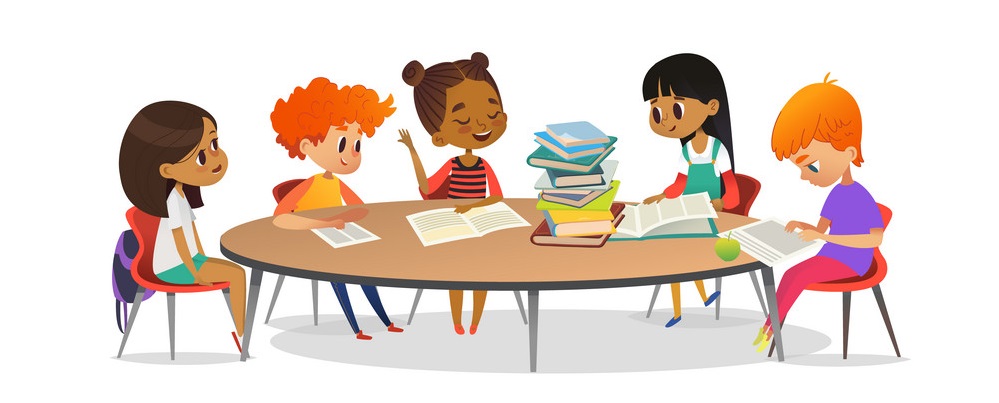
Bernie Sanders is scheduled to give a speech later today calling for major reforms to our public education system.
In a major education policy speech set to be delivered Saturday, Sen. Bernie Sanders will call for a ban on all for-profit charter schools, a position that puts him directly at odds with the Trump administration and becoming the first of the 2020 Democratic presidential candidates to insist on such a move.
The Vermont independent also will call for a moratorium on the funding of all public charter school expansion until a national audit on the schools has been completed. Additionally, Sanders will promise to halt the use of public funds to underwrite all new charter schools if he is elected president.
A senior Sanders campaign official shared the details of policy proposal with CNN ahead of the Sanders speech in South Carolina — the crucial early primary state where the African-American vote is a key voting base. The moratorium on the funding of public charter schools was initially called for by the NAACP; Sanders will say in his speech that he supports the group’s efforts.
Sanders will also make the case that the growth of charter schools has done disproportionate harm to the black community because it has pulled public dollars away from community public schools.
He will give his speech in Orangeburg on the anniversary weekend of the historic Brown v. Board of Education Supreme Court decision that ruled that segregation in public schools was unconstitutional.[…]
According to the campaign, Sanders will outline a series of reforms he deems necessary to charter school policy. Among them:
• Mandating that charter schools comply with the same oversight requirements as public schools
• Mandating that at least half of all charter school boards are teachers and parents
• Disclosing student attrition rates, non-public funding sources, financial interests and other relevant data
• Matching employment practices at charters with neighboring district schools, including standards set by collective bargaining agreements and restrictions on exorbitant CEO pay
•Supporting the efforts of charter school teachers to unionize and bringing charter schools to the negotiating tableSanders will concede that the initial goal of charter schools — to help kids with unique learning needs — was admirable. But he will argue the system has been corrupted by wealthy activists who spent millions to privatize these schools, leaving them unaccountable and draining funds from the public school system.
—CNN, “Bernie Sanders will call for ban on for-profit charter schools“
I haven’t studied the proposal or even the larger topic enough to know whether it’s good policy. And I have serious doubts as to whether the federal government has the Constitutional authority to ban for-profit charter schools.
That said, inequality within our public school system is a serious problem. Quality varies wildly from school to school, partly because of community demographics and partly because we fund schools at a local level. Obviously, this creates disparate impacts based on race, income, and other social factors.
I’m in the process of remarrying and, with that, creating a blended family. Although the house I bought thirteen years ago with my late wife is much nicer than any I’d ever expected to live in—and have lived here by far longer than any previous home—it really doesn’t meet our new situation very well. So, we’re seriously exploring a move.
One of the reasons, naturally enough, is the state of the public schools. We live in Fairfax County, Virginia, the second most affluent county in the United States. Our combined household income is approximately twice the median for the county. Yet our schools suck:
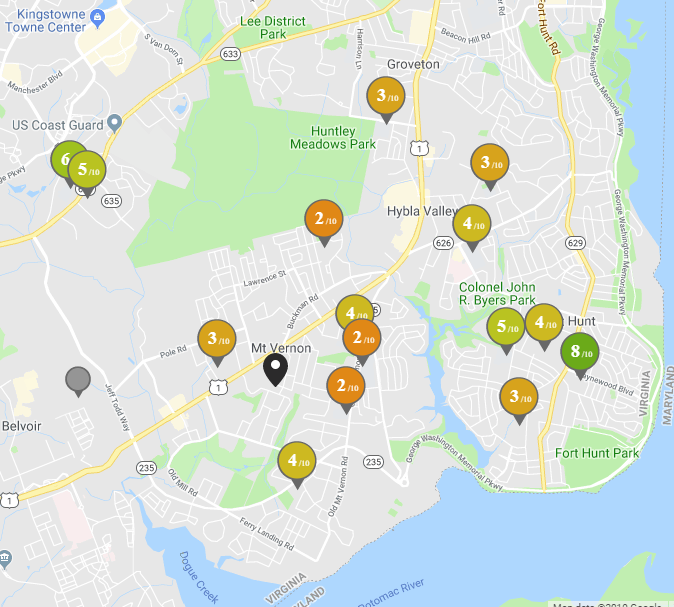
The elementary school within short walking distance of me is rated a 2 on a 10-point scale by GreatSchools.org. Oddly, we’re not districted for that school but one about half a mile further down the road. It’s also a 2. The middle school is a 4. The high school is a 2.
Because we moved Kim’s mom down to be the nanny, I’m able to send my girls to the elementary school associated with her neighborhood. It’s an 8–the only one on the map.
Why? Despite her immediate neighborhood being much less affluent than mine, her elementary school district is comprised entirely of single-family homes whereas everything from mini-mansions to apartments to trailer parks feed into my local school.
Still, the middle schools and high schools feed from multiple elementary schools and the schools they would go to down the road are both 4s. And, again, that requires me sustaining the expenses of a second household.
Moving 10 to 15 miles changes the picture entirely.
Here are the high schools for the greater area:

As you can see, there are sectors of 2’s, 3’s, and 4’s—below average schools—and many pockets of 7’s, 8’s, and 9’s—above-average schools.
The 10? Thomas Jefferson High for Math and Science. It’s the top-rated school in the entire country. But it’s also not a neighborhood school but a public STEM charter that’s extremely competitive.
You will likely not be shocked to discover that there’s a strong correlation between the rating of the school and the demographics. Most of the 2’s, 3’s, and 4’s are majority black and Hispanic. Thomas Jefferson is two-thirds Asian.
Here are the middle schools:
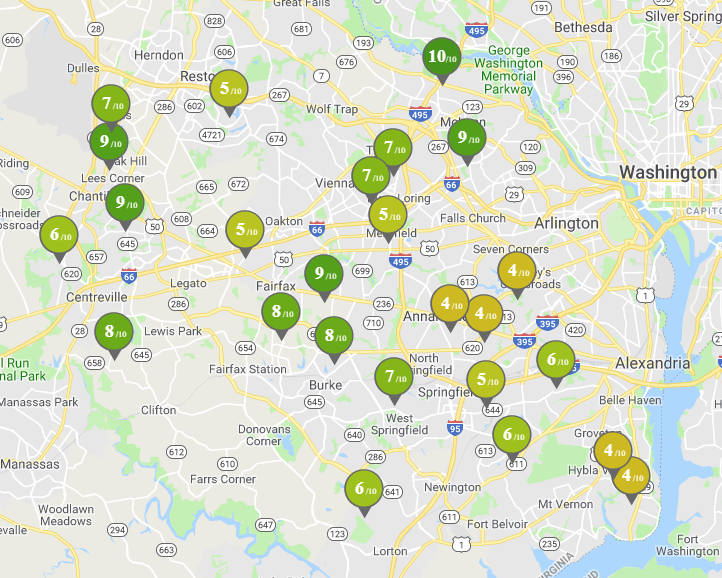
Again, rather stark. No 2’s or 3’s but lots of 4’s and 5’s. And tons of 8’s and 9’s.
The elementary schools are harder to show because there are so many of them and the interface defaults to showing the top-rated schools. So here are a couple of views using ZIP codes just a couple miles apart:

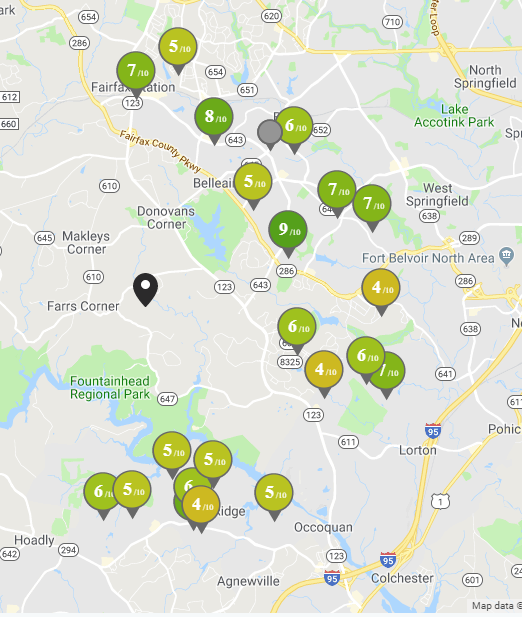
It’s also worth noting that, because of the vagaries in which elementary schools feed into which middle or secondary schools* it’s possible to be districted for a high school that’s an 8 and an elementary school that’s a 5. We’ve ruled out houses for precisely that reason.
And, of course, one can buy a house with an elementary school that’s an 8 and a secondary school that’s a 9 but either see a drop in the school ratings or, more insidiously, see the districting lines change and wind up going from an 8 to a 5.
Now, my late wife and I of course understood this situation somewhat when we bought the house. But we were newly married and childless. We hoped to and were lucky to have two kids but elementary school was a minimum of seven or eight years down the line and, as I put it at the time, we can’t buy a house based on the theoretical educational needs of a theoretical child several years into a theoretical future. We might, after all, decide to move by then for any number of reasons.
Still, we vaguely understood that school districts mattered and considered that when buying. But, not as motivated by the schools or as equipped with the technology to easily analyze them with this level of granularity at the time, we ultimately decided that it didn’t make sense to spend radically more money or buy significantly less house to buy in McLean or Great Falls rather than Alexandria—especially when the latter was more convenient for our extant jobs.
At the end of the day, our kids are going to be fine. We’re both reasonably affluent. We both have doctorates. So they’re going to get the resources they need to succeed in school.
But, given the undisputed importance of education in a modern society, the fact that school quality varies so much from neighborhood to neighborhood is astounding. The “2” school into which my house is districted and the “8” school in which my other house is districted are 4.2 miles apart. We’re likely going to move 10 or 12 miles to buy into schools that are 8’s and 9’s. It’s crazy—if not tragic—that that’s an option.
And, of course, it’s not an option for the people whose kids would most benefit from their kids being in great schools.
____________
*Oddly, despite a central county board of education, some areas have middle schools (7-8) and high schools (9-12) while others have secondary schools (7-12). And at least one community I’ve found has one elementary school for pre-K through 2 and another for 3 through 6.

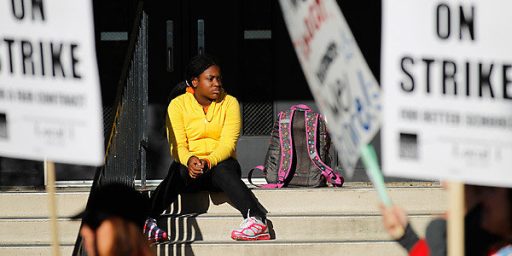




Just out of curiosity, what are these ratings based on? It’s always been my understanding that, as a general rule, Fairfax County’s schools are among the best in the area. Obviously, not all of them are or can be Thomas Jefferson High School, but from my conversations with people who lived in various parts of the county, parents were pleased with the quality of the schools their kids went to. There were, of course, the usual complaints about class size, overcrowding, and the fact that some schools were holding classes in temporary trailers because they didn’t have classroom space but on the whole, they seemed happy. The same goes for parents in Prince William County (with the exception of some schools in the Cities of Manassas and Manassas Park, but that’s another issue since they are independent of PWCPS), Arlington, the City of Alexandria, and Loudoun.
As for Sanders “idea,” I fail to see where Congress would even have the authority to do what he’s proposing,
No, it’s planned.
W@OzarkHillbilly:
Even assuming that this ratings system is reliable, it’s inevitable that not every school is going to be a 7-10 no matter how much money you spend.
@Doug Mataconis: They outline their summary ratings process here. It’s based on standardized test scores, which obviously have some biases, but also a variety of other factors which they detail here. Overall, Fairfax County indeed has bery good schools. That’s because there are enough 7s, 8s, 9s, and even 10s to outweigh the 2s, 3s, 4s, and 5s. But that doesn’t help the kids in the below-average schools. (And these are nationally-based, not locally. So there’s not a Lake Wobeggon effect here.)
I agree that there’s likely not a way to have all the schools be equal if we want kids to be able to go to school close to home. But there should not be this level of disparity within a 10 or 15 minute drive.
And we’ve looked in Prince William County, since it’s both cheaper and closer to work for both of us. Alas, the high schools mostly suck and the good schools are actually further away from work than where we live now. Ditto the middle schools. And the elementary schools in the part of the county convenient to work are simply atrocious.
@Doug Mataconis: they’re undoubtedly going to try to use the “receives public funding from the government”==> “right to pass laws controlling charter schools” argument.
@grumpy realist: I think the Federal government rather clearly has the authority to deny Federal funding to private schools. I don’t know where they’d get the right to ban their existence.
@Doug Mataconis: Absolutely agree Doug, but that is beside my point, which is that probably 95% or better of 7-10 schools are in wealthy school districts and 99% or better of 2-3 schools aren’t.
@James Joyner: That may be what Bernie is really referring to but I doubt even he knows.
@OzarkHillbilly:
Bernie has a habit of throwing ideas out there without being clear on how those ideas would work in reality or how he’d pay for them.
One of the reasons I can’t take him or his acolyte AOC seriously.
@James Joyner:
For better or worse, there is always going to be a correlation between school quality and socio-economic status. In part that’s due to the fact that schools in more well-to-do areas have more money to work with (although that shouldn’t really be relevant given that schools in Virginia, as opposed to the state of my birth New Jersey, are generally funded at the county level). Another important factor, of course, is parental involvement in the schools and the extent to which parents are willing and able to volunteer at their local schools or spend money for tutors or other methods for their kids to get education above and beyond what they’re learning in school on a daily basis. It’s also dependent on the extent to which parents show, by example and action, that they are engaged, interested, and involved in making sure their children are getting a quality eduation. Let’s face it, that isn’t always true of all parents sadly and there’s not much that schools or teachers can do about that no matter how good they are. Finally, some schools in the D.C. area have to deal with issues such as E.S.L. students and higher than average immigrant family populations than others and that also impacts performance and can impact performance. As just one example of that I recall talking to a teacher who worked at one of the better middle schools in Fairfax but which also had a high population of ESL students. One time, they had a child enrolled who spoke a dialect from Nigeria that was so obscure that they actually had to contact the linguistics department at Georgetown in order to find someone who could help them communicate with this child.
My final observation is that no matter how much you try to make all schools equal there are always going to be some that are better than others. As you say, Fairfax County is not Lake Woebegon after all.
I feel your pain. I had to move for similar reasons 10 years ago, lovely neighborhood, but the public E/M/H schools we would have to send our kids to were rated F, D, and D. Moved 3 miles for a A,B, and A rated cluster. Of course, then my son got drawn for probably the second best charter school in town, so now we’re driving the kids 5 miles every day to a bus…
@Doug Mataconis: My fiance is a former schoolteacher and much more equalitarian on this than me. I tend to agree with you that the factors you cite make equality impossible. Still, using the area where I live as an example, it would be relatively easy to assign households to nearby schools in a way that would spread the resources more fairly. There should not be one “8” and the rest “4” or “2” in a 10-minute driving radius. And I say that as a parent whose kids go to the 8.
@James Joyner:
I get that point, and tend to agree. But there are two ways to make things equal. One is to make the 2-4 schools better. The other is to make the 6-8 schools worse. Obviously, the goal should be the first not the second.
The question is what the cause for the difference is. Is it the location, the students, the teachers, the parents? Some things are easier to change than others and, of course, there are costs associated with any options that you look at and funds are, and always will be, far less than the lofty goals that some may have.
I’d also add that trying to equalize outcome can backfire. When I attended school in New Jersey there were seven and at one point eight K-5 elementary schools. Some were better than others, obviously, and partly in reponse to that when I was in High School they rearranged everything to so that there were four Elementary Schools (K-3) and two “Intermediate” schools (4-5). All it really appears to have done is bring the general quality of elementary school education down and create headaches for parents who had to place little children on buses to get them to school rather than letting them walk to school, which I basically did nearly every date up until I went to High School
Ah yes, Sanders has a hammer, and everything is a nail. The solution for him is always to have a government ban what he doesn’t like and turn government into a crony for what he does.
As far as your thoughts on schools generally, I have three kids, moved frequently due to being in a military family, and have dealt with the issue of schools and where to live many times.
Here in Colorado the state government explicitly normalizes school district funding across the state according to a set formula. School districts in poor areas get more money per-pupil than districts in rich areas. Yet the disparity in schools still exists. And Colorado has one of the lowest per-pupil spending rates in the country thanks to TABOR, yet we still have many excellent schools and districts.
The school district that we’re in now is one of the top-five in the state, yet the per-pupil funding for this district is well below the state average.
Clearly, money isn’t everything or even a primary causal factor in school performance. The reality is that there are, and will always be, a non-trivial number of parents who will move or do what they think is necessary to get their kids into a “good” school and then there are parents who either won’t do this or can’t. Self-selection is what creates the disparity, not lack of throwing money at the problem.
Great Schools shows the pernicious connection between real estate prices and school scores. I’ve been observing up close the disconnect between factors like graduation rates and education.
My two local high schools earn a 9 and a 10 respectively. As much as I criticize educators they have both been great. One kid is a hare, the other a tortoise, both had to be dragged kicking and screaming by amazingly dedicated teachers and administrators. In the end both schools essentially passed my kids just to keep their pass-fail numbers looking good, because by any objective measure both kids should have been tossed out on their ears for heroic levels of truancy and a near-total failure (refusal) to do projects or homework.
Now, as to education, aside from my youngest daughter’s discovery of ceramics, almost no education occurred for either kid at any point. Last week my youngest texted me from her English class which is focusing on humor to ask WTF the point was, how this would help her in life. I couldn’t lie, so I told her it wouldn’t, that she was just to drag her ass to the finish line. Granted my kids are both outliers at different ends of the bell curve, but Jesus what a massive, soul-sucking eight years in total. Eight man/child years, for what? Pieces of paper certifying not that either kid learned a single thing, but that they each spent four miserable years being bored and were graduated practically against their will to help prop up Marin County’s real estate prices? Hurrah.
I don’t know what school is like for kids in the plump middle of the bell curve, I imagine the STEM kids learn something. But there has to be a better system. So much time, so much money, so much damage done to vulnerable kids, for what? One of my kids can throw a beautiful pot. As far as I can see, that was the total net benefit. I have a fuckton of pottery and my monthly rent is a teacher’s monthly salary.
@michael reynolds:
Many districts I’ve been in have programs or even schools for kids at the ends of the bell curve. My middle child is currently in a “hybrid” school where they learn on their own at home three days a week and go into a central “hub” two days a week for group projects, some group instruction, and social interaction. It’s worked well, but he wants to do regular high-school next year.
Some states allow virtual schools where the curriculum can be student or parent-driven. These are kind of like homeschooling, but more formal as it’s not just the parents. Kids still have to have instruction in certain areas (mandated by the state) and have to take the state standardized tests, but otherwise, the actual instruction is very flexible.
Long story short, there are options out there for kids who aren’t compatible with the public school mass-education grind, but they’re sometimes hard to find and vary widely from stat-to-state. They definitely require more parental involvement and oversight which is very difficult for some families.
There are many low income and inner-city schools that excel. How do they do this? With lots of money? No. They start with excellent leadership. Leadership that pushes excellence from the hall behavior to reading novels* , high standards, and responsibility. Heavy parent involvement is a given. The principal runs the school and the teacher runs a no nonsense classroom.
The problem is that over the years many schools have become increasingly run by career bureaucrats and judges who have no experience in the classroom. They need to head back to their golf courses and leave teachers to do what they are experts at. A politician should not be telling a teacher with years of experience and advanced degrees how to do their jobs. Other countries respect their teachers.
Look at the schools that are succeeding: do what they do.
*Is the golden age of the novel over? It was kids reading everywhere: “Harry Potter”, “Twilight”, “Percy Jackson”, and “Hunger Games”. I am not seeing or hearing about a reading craze now.
The issue is that it’s easy to create high quality schools. What is difficult is creating high quality school systems. It’s easy to improve student indicators by just eliminating a small percentage of low performing students, something like one or two per class.
The problem is that low performing students need to go somewhere. Unless you have charter schools absorbing entire districts it’s difficult to have an answer whether they are intrinsically better than public schools.
To me both charter and public schools should be more integrated, with charters being more experimental and even having charters receiving low performing students from public schools.
It’s good to see Bernie working to revive the 19th century efforts in education. But as noted above, private schooling, even if religiously affiliated has a long standing precedent supporting it. Perhaps Bernie or some other Democrat could introduce a “modernized” Blaine Amendment for secular private schools as well. Of course, there would need to be an exemption for the special born who attend the elite private schools that surround Washington.
Oddly, most of the success stories for charter schools come from minority parents who feel their child was saved by escaping the compulsory state schooling that is generally of poor quality, especially in areas of diversity.
Mises was writing from the perspective of the Great War and it obvious today that some public funds are necessary. But no one should doubt that the real purpose of this proposal is to keep the children on “their hundred,” i.e., school district/zone, so they can’t escape being tied to the land.
@JKB: As problematic as our public school system is, to go to a system of non-public education is to create a world (or, more accurately, re-create one) in which some are educated, and others are not.
@Andy:
We sent the potter to a highly-regarded private, special needs school for her middle school years. Want to find a way to burn 100 grand in tuition? I got just the place. Private schools still follow the same paradigm: kids in a room listening to irrelevant bullshit from a teacher who doesn’t really know the subject. We did ‘remote learning’ for a few years with the older one and I will say that though it was a complete waste of time, at least there was no car line involved.
@Tyrell:
You seem to imagine that extraordinary teachers and stellar administrators are something we can just mass produce. What we are capable of producing in large numbers are average teachers and administrators. (It’s in the math).
As to kids reading, we’ve (writers) been trying and we succeeded. For a while. Then the do-gooders stepped in and gutted the market by deeply stupid demands that kidlit be diverse in the least effective ways possible. Diverse (my books have been since the early 90’s) suddenly wasn’t enough, it also had to be righteous and good for you and only in the most obvious and unreadable ways. If you want to convince kids not to read, insist that books be ‘good for you’ as determined by not-terribly-bright gatekeepers.
@michael reynolds:
Back when the only acceptable careers for women were teacher, nurse or secretary, we got some of the best and brightest women as teachers. Now they can become engineers, managers, doctors, … it siphons off some of the best.
@michael reynolds: @Gustopher: Not only have we lost the talent pool created by women having limited options but we’re still recruiting and paying as though women still had limited options. Ultimately, I think that’s resulted in mostly mediocre people going into teaching because they think they get summers off. And the bureaucratic hoops make most of the relative handful of very smart teachers leave in frustration early.
@michael reynolds:
The non-traditional options we’ve used were all part of the public school system. Many districts have these options and they can be a good fit for some kids.
@Tyrell: I see lots of reading going on when I substitute at the middle and high schools in my little town. The difference these days is that instead of all the students reading one monster best selling book, the reading is distributed among 15 or 20 different series and graphic novels (gasp!!!–but I will still note that the research for 40 some years now has consistently shown that more reading is always better than less reading regardless of genre).
The benefit to the schools in this change is that they don’t need to buy 20 or 3o copies of some book, that will become passe the following year, to stock enough library copies to meet demand.
@Steven L. Taylor: To JKB, that’s a feature not a problem.
It may not be the case everywhere, but in the areas that I’ve lived in the case for middle (6-8), junior high (7-9), and comprehensive (6-12) has normally been matching building size to cohort breakdown. Elementary schools became over crowded and high school enrollment dropped, so they moved the 6th graders to the junior high and the 9th to the high school. You adjust the school configurations to match the bulges in demographics. It may be that there are some true believers in ‘middle school concept’ now, but back in the 80s that didn’t seem to be the case.
I went to three of the worst schools in Los Angeles. Not at the bottom, but close. My high school had three gang shootings my Senior year. We graduated less than 300 seniors in 12th grade out of a 10th grade class that had over 1000 kids.
Yet I got an amazing education. Why? Because my mother was just this side of a corrections officer when it game to my studying. She pushed and pushed and pushed my sister and I. So, despite a crappy school, gang violence all around me, friends who were drunk, stoned, or both, most of the time, I managed to not only graduate, but also go to a Junior College then to a University.
We shouldn’t let parents off the hook here. As MR posted above, even with engaged parents, it will be tough to actually educate your kids. But there has to be an effort on the part of the parents to get involved, stay involved, and guide their kids’ education process.
@Just nutha ignint cracker: That makes sense, actually. My fiance is a former schoolteacher with an EdD and is shocked that so many places don’t do a K-6, 7-9, 10-12 “middle school” concept but it seems to be a rarity.
@EddieInCA: Oh, no doubt. I mostly figure that the better schools are likely to have more motivated teachers, more of the parents engaged, and fewer problem children. That should translate to a better instructional environment. It’s especially important for my 10-year-old, who’s ADHD and easily bored.
@EddieInCA:
Absolutely parents are key. And who are the parents with the knowledge and the spare time to be able to help? They are more likely to be well-off and from stable families. The wealth effect is self-perpetuating.
As an English teacher I used to get asked this all the time, “how will [poetry, Shakespeare, whatever] help me in life/my job”.
Well, it might not and that’s not the point of school. School isn’t there to train you for a putative future job. If you knew a kid was destined to be a plumber would you only teach them about U-bends? No, teach them osmosis, algebra, Shakespeare, music, poetry, sport. Give them a broad and varied curriculum that will give them an intellectual hinterland and an enriched life.
This is also the argument you can use against those vacuous techbros who think school should be back-to-back coding because 21sr century jobs or something. My kid can learn to be a techbro when they grow up, if that’s what they want to be. School isn’t preparation for work, it’s building powerful knowledge and exposing kids to interesting ideas for the sake of having powerful knowledge and being exposed to interesting ideas.
Also, on topic, Bernie’s idea is dumb.
@michael reynolds:
They are. It’s a matter of training, knowledge and spare time, not of effort. Many low income parents(Or worse, many low income moms) lack the tools, not the will.
So many things to say on this subject.
1) Tyrell isn’t ridiculing teachers for working only 6 hours a day and 9 months per year! WTF, man, did you lose your Republican cheat sheet?
I’m kidding around … and we are in 110% total agreement that bureaucrats/judges/administrators/politicians need to let teachers teach.
Anecdote: Due to the particular nature of one of my kids and also the situation in his grade at the local public school (read: class size), we send him to private school. We pay a ridiculous tuition for him to go there. And would you believe what the principal of this expensive private school does all day? He gets the hell out of the way. And how do the teachers respond? They come up with innovative stuff (which the principal funds), and the teachers are all happy and energetic and the kids have fun learning from them. Nobody’s drilling them on test scores, and yet this school still outperforms the average private school by a decent margin (and it’s not even a contest with public schools). It’s almost like it’s the principal’s job to support the teachers, rather than the other way around.
2) Charter schools. Bernie’s first proposal regards the fact that they don’t adhere to the same rules as normal public schools. And yet some of these charter schools are actually innovative and effective. Rather than ask them to follow the same rules, why not ask why we have these rules that prevent public schools from being innovative and effective? It seems to go back to Tyrell’s point about politicians foisting bureaucratic BS on the public schools.
3) This is not directly related to charter schools, but let’s talk about mainstreaming. It’s a noble idea that has ruined many a classroom. Either properly fund aides to stay in the room at all times with special needs kids that are disruptive, or keep those kids in the special ed room. Sorry, there are no other choices here. I had a close relative that I loved who had special needs. She didn’t belong in a regular classroom – it would have frustrated her at least as much as it would have frustrated everybody else in the room.
FWIW over at Newyork mag, Jonathon Chait agrees with Dr Joyner’s general point regarding Sen Sanders’ idea: Bernie’s worst idea ever.
Did many of the readers here see that day coming?
Minor quibble — TJHSST is not a charter school; it’s a public magnet school. The “state-chartered” part of its description means that the local district (Fairfax County Public Schools, in this case) gets state funds to operate magnet programs.
Bigger quibble: all of the metrics used by GreatSchools.org are outcome ratings, not impact ratings. They take no account of where the kids started. A school that is routinely getting migrant worker kids into local junior colleges will look worse than a school that is routinely getting CEO kids into state universities.
@DrDaveT:
Fair enough. I was only vaguely familiar with them before I started the house search and got into the school ratings.
@DrDaveT:
Yes, I agree. My fiance is more insistent than I am that the ratings are unfair. Yet, absent a better metric for evaluating a staggering number of elementary-middle/secondary/high combinations, we’ve agreed that we’re excluding any houses where the schools are under a 7 because, hey, it can’t hurt and might help.
This problem occurs in other countries as well.
This would mean that it is a natural progression of out natural being to strive for excellence even when we know we tilting the scale of social privilege in our favour.